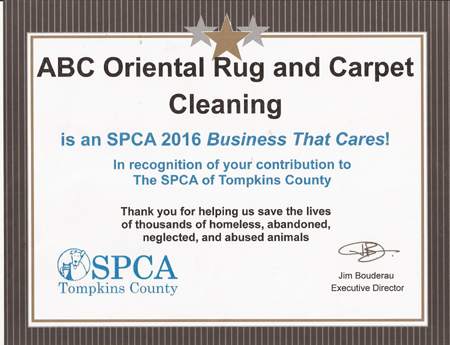ABC MONTHLY NEWSLETTER
FEBRUARY 2018
Welcome to Our Monthly Newsletter!
We hope you will enjoy this month's articles.
This month's topics are:
ORIENTALRUGS
TILE & GROUT
CARPET CLEANING
Specials
If there is a topic you would like us to cover in one of our upcoming newsletters, please call us at 607-272-1566 or contact us by clicking here.
IT'S TIME FOR OUR REGULAR CUSTOMER APPRECIATION DISCOUNTS for FEBRUARY!
(RCAD)
See below for details!
QUM ORIENTAL RUGS
LOCATION - QUM PROVINCE, IRAN
Qum oriental rugs (Qom, Ghom, Ghum, Ghoun, Kum) are woven in Qum, a large city in Iran, 90 miles south of Isfahan and about 60 miles South of Teheran, the capital city of the Iranian Government.
As the center of the Shia Theocracy, Qum is one of the holiest cities in Iran. This very old city has a rich religious history and contains many impressive architectural monuments.
WEAVING HISTORY
Surprisingly, Qum oriental rugs have only been woven since the 1930s. Around that time, rug merchants from Kashan began to move their looms to the oasis of Qum.
Once settled there, weaving flourished as artisans incorporated a large variety of styles, while managing to retain characteristics that are distinctly recognizable as Qum rugs.
Today, the largest amount of silk rugs from Iran are made in Qum.
CONSTRUCTION OF QUM ORIENTAL RUGS
The construction of Qum oriental rugs was and is unique. They use very fine silk fiber and the smaller diameter of the silk fiber allows for meticulous detail in the designs. The details are never compromised.
THE FOUNDATION
The foundation of the Qum oriental rugs contains depressed warps (up & down foundation cords). Depressed warps occur when the wefts (side to side foundation cords) are pulled tightly from either side rather than put in with minimal tension. This will displace the warps into 2 levels.
The warps are cotton or silk with 2 shoots of cotton or silk for the wefts. The cotton may be dyed blue or light gray.
THE PILE
Soft silk or high quality Kork wool is used for the pile. The highest quality Qum rugs are made of pure silk.
You can also find wool pile rugs with accents of silk (usually outlining designs), and silk pile rugs on silk and cotton foundations, as well as rugs made entirely of silk.
THE ENDS
The bottom of the rug has twisted uncut loops. The top end has a kilim (a flat area of varying size woven at the end of the rug before the fringe is finished) with knotted fringe.
THE SIDES
The sides contain a single cord, overcast in wool or silk.
THE KNOT
The knot is the Persian or Senneh asymmetrical knot. The yarn is placed in a loop around one of the warps (up and down foundation cords) and remains loose under the other. The 2 ends emerge on either side of the warp. In the Qum rug, the knot opens to the left.
Knots per square inch (KPSI) is used to measure the knot density, which is one measure of the quality of a weaving. The KPSI of Qum rugs is quite high.
THE DESIGN
For more information about Persian Qum Oriental Rugs with photos including designs, colors, sizes, how to identify these rugs, etc., please continue reading here.
GROUT SEALING
DOES YOUR GROUT NEED SEALING OR RE-SEALING?
Have you scheduled a tile and grout cleaning job or done it yourself and wondered if you need grout sealing as well?
It is relatively simple to find the answer to your question. Simply sprinkle a few drops of water at several places around your tile. If areas of your grout soak in the water immediately, your grout should be sealed or re-sealed.
WHAT IS GROUT?
Grout is used to fill the seams between tiles. Most grout is called 'sanded grout' because the grout contains sand, which is a good and inexpensive material to use. Unfortunately though, sand is porous and therefore grout is porous. It is this porosity that makes it necessary to seal the grout after the majority of tile applications, as well as re-seal the grout when needed.
After grout has been applied and has dried, but has not yet been sealed, it will absorb water and any other liquid, as well as dirt, mildew, and other contaminants through its microscopic pores that act like a sponge. Obviously, this is not a good situation for a shower wall or bathroom floor but can be a problem in any area where tile has been laid and grout has not been sealed or the seal has worn off.
Please note: There is a type of grout which is epoxy-based called epoxy grout or pre-sealed grout. This type of grout does not need sealing because it actually sheds water. It is relatively expensive and difficult to mix so is not used as much as sanded grout.
WHY WASN'T MY GROUT SEALED BY MY CONTRACTOR?
The usual answer to this is--If a sanded grout was used and it was not sealed, it may be the fault of the contractor.
To seal the grout in a new installation means returning at another time because the grout must be completely dried after installation. This can take as much as 30 days. Many contractors do not want to, or may not have the time in their schedule, to return to the site to do this.
WHY DOES MY INSTALLED GROUT NEED SEALING IF IT WAS SEALED AFTER INSTALLATION?
Existing tile may need to have the grout sealer reapplied. Bathroom wall tile and tile kitchen counter tops especially, may need to have the grout sealed more frequently.
Since grout is porous, spills may seep in if not cleaned up immediately. Colors from liquids such as fruit juice or tea and coffee may remain after the liquid evaporates, staining the grout. Oils can also seep into the grout. To remove these stains, the old grout may need to be chipped out and replaced. NOTE: There are some types of grout available that are non-staining.
PROTECTION FROM MOLD & MILDEW
Grout is not as resilient as the tiles surrounding it and applying grout sealer can provide good protection, especially against mold and mildew as in a bathroom situation. The combination of continuous water exposure and warm temperatures can cause slow chemical changes in the structure of the grout. The minerals that compose the grout structure can dissolve away, allowing water to go even deeper.
It is important to note that as the minerals in the grout dissolve, the alkalinity of the grout is reduced, eventually allowing bacteria to survive and reproduce as well. The water may reach the mortar at the base of the tile, compromising the drywall backing and the entire tile assembly.
IF MY GROUT NEEDS TO BE SEALED, HOW OFTEN SHOULD IT BE DONE?
Please continue reading here for the answer and for more information about grout sealing.
COMMERCIAL CARPET CLEANING
(Differences from Residential Carpet Cleaning)
Commercial carpet cleaning is different from residential carpet cleaning because commercial carpets and residential carpets are specifically manufactured to be used under different conditions.
Carpet for the home usually has fibers and padding that are thicker than typical commercial carpet, since its usage is based on appearance, comfort underfoot, and noise reduction.
Commercial carpet, on the other hand, is specifically made to handle a great amount of foot traffic, some of it quite heavy. The thickness of the carpet fibers as well as that of the padding, if there is any, depends on the many different usage requirements found in commercial settings.
CHALLENGES FOUND IN COMMERCIAL CARPET CLEANING
The commercial carpet cleaning technician has to be able to handle a variety of challenges not normally found in residential carpet cleaning. These include:
- Heavy foot traffic.
- Exposure to many more (though not always much different from residential carpet) contaminants, such as grease, tar, gum, beverage and food spills, copy toner, and even blood.
- The clean up of spills and other contaminants in a timely manner is in the control of the building staff (usually at night). If the staff is not trained in proper spot and spill removal or the removal is not timely, these contaminants may become permanent stains and the carpet cleaning technician may not be able to remove them successfully.
- Although truck-mounted hot water extraction is the recommended cleaning method for most residential carpet, commercial carpet cleaning may require different methods or a combination of methods, such as portable hot water extraction, bonnet cleaning, dry cleaning, etc. The choice of methods depends on the unique situation of each commercial building or area, as well as how soon it needs to be dry.
- Commercial cleaning must usually take place out of business hours and on weekends.
LENGTH OF TIME BETWEEN CLEANINGS
Many factors come into play when determining the length of time between either commercial or residential carpet cleanings.
As a general recommendation, residential carpets should be cleaned at least once a year while commercial carpets should be cleaned every 6 months. Of course, these are just estimates.
The homeowner can more easily keep track of the requirements of individual areas of carpet in the home.
The company providing commercial carpet cleaning will often make recommendations to the manager of a company for the appropriate times for carpet cleaning for a particular building. This estimate is necessary in order to efficiently manage dirt and stains and improve the appearance of the carpet in the building.
MAINTENANCE OF CARPETS BETWEEN CLEANINGS
For more information on commercial carpet cleaning, please continue reading here.
RCAD FOR 2018
JANUARY 2nd thru MARCH 31st
~~~~~~~~~~~~~~~
CARPET CLEANING
20% Off for the entire period.
See our FAQs on Carpet Cleaning here.
~~~~~~~~~~~~~~~
FEBRUARY RCAD
TILE & GROUT CLEANING
25% Off
and
COMMERCIAL CARPET CLEANING
25% Off
See our FAQs on Tile & Grout Cleaning here.
~~~~~~~~~~~~~~~
MARCH RCAD
ORIENTAL & AREA RUG CLEANING
30% Off
See our FAQs on Oriental & Area Rug Cleaning here.
~~~~~~~~~~~~~~~
Services Above Paid by Cash Qualify for an EXTRA 5% Off!
~~~~~~~~~~~~~~~
MORE DISCOUNTS AVAILABLE!
With Carpet Cleaning Special
10% off Topical Treatments:
~~~~~~~~~~~~~~~
For February - Extra Discounts:
20% Off Grout Sealing
15% Off Pickups & Deliveries
~~~~~~~~~~~~~~~
CALL ABC at
607-272-1566
for more information.
THANK YOU!! WE LOOK FORWARD TO CONTINUING TO SERVE YOUR TEXTILE CLEANING AND REPAIR NEEDS!
Get New Posts Right To Your Inbox!
Get our monthly newsletter, just like this one, delivered right to your inbox each day. Just sign up and we will send you the best new articles and videos as they become available.
Your email address will NEVER be spammed, sold, or shared. You are welcome to unsubscribe at any time with the link in the email.
Top of February 2018 Newsletter
"The Cleanest Clean You've Ever Seen."
by
ABC Oriental Rug & Carpet Cleaning Co.
130 Cecil Malone Drive Ithaca, NY 14850
607-272-1566

ABC
Carpet & Rug
Spotting Guide

ABC Oriental Rug & Carpet Cleaning Co. has been family-owned and operated in Ithaca and surrounding areas for more than 48 years.
Our company is a reflection of our family name and pride.
Please Like us on Facebook!
for more information and to find out what we are doing at our business and in the community!
Stay Connected!
Links to Our Services
Allergy Cleaning
Area Rug Cleaning
Oriental Rug Cleaning
Rug Hand & Machine Repair
Upholstered Furniture Cleaning
Tile & Grout Cleaning & Sealing
We are proud sponsors of the SPCA of Tompkins CO:

Newsletter Archives

